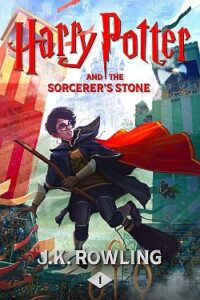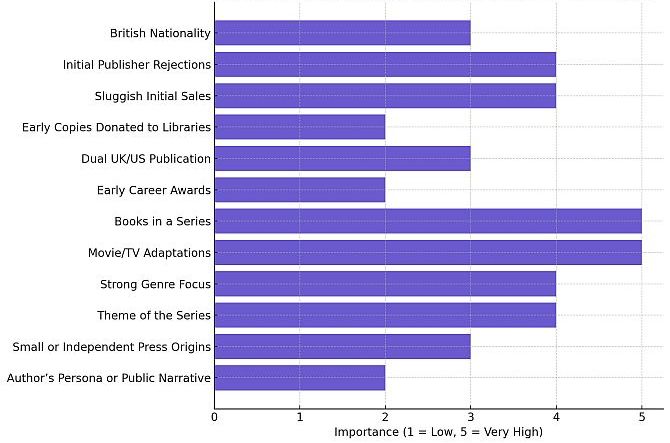It usually takes decades for a book to gain significant collectible value in the rare book market. That wasn’t the case for the most successful author of this century, J.K. Rowling. Her first book, Harry Potter and the Philosopher’s Stone, appeared on June 30, 1997. By the time her third volume, Harry Potter and the Prisoner of Azkaban, was delivered to stores by July 1999, it was a news-leading event. Within two years, J.K. Rowling had established cultural significance.
It is believed that more than half a billion Harry Potter books have sold so far, with some of the most collectible editions selling for over one hundred thousand dollars.
What are the most influential factors that can produce a top-selling author with collectible impact in such a short period of time? In order to gain some insight, we analyzed twelve key factors that likely contributed to J.K. Rowling’s impressive status as a collectible author:
- British Author
The UK is the world’s largest exporter of books, with 60% of its publishing revenue—amounting to £4.1 billion—coming from international markets. The United States stands as the UK’s largest export market for both print and digital books, with sales increasing from £193 million in 2018 to £260 million in 2023. There are about 78,200 UK authors currently active.¹
British authors writing in English are often well-positioned for global reach, especially with dual UK/US releases. While not essential, Anglophone writers from the UK, Canada, Ireland, and Australia are perceived to possess literary pedigree with international appeal.
- Rejection by Publishers Initially
This creates a narrative of underdog triumph, enhancing author mythology. Twelve London publishers turned down Harry Potter and the Philosopher’s Stone before it was published by the independent Bloomsbury.
- Sluggish Initial Sales
Poor early sales mean small first print runs and limited distribution—key conditions for scarcity. If the author later becomes famous, those early copies surge in value. With such a small window between early publications and phenomenal success, the supply of early editions is extremely limited.
- Early Copies Donated to Libraries
While promoting exposure for lesser-known authors, library copies are often discarded, damaged, or rebound—making surviving examples rare. When identified, they become prized.
This is a strong scarcity signal, but only relevant if other factors (e.g., later fame) occur. Library provenance usually lowers value unless it’s a confirmed rarity. Harry Potter and the Philosopher’s Stone was published by Bloomsbury in a run of 500 copies, most of which went to public libraries.
- Published by a US Publisher in Addition to a UK Publisher
An American publisher, Scholastic, pitched in with $105,000—a record advance for a children’s book—and amended the title of the first in the series to Harry Potter and the Sorcerer’s Stone. It was released in August 1998, by which time the second book was already out in the UK.
Dual market exposure boosts readership and demand.
- Early Career Awards
Two awards—one from a confectionery brand, the other an industry award for Children’s Book of the Year—put Harry Potter into reprint. Awards like the Carnegie Medal, Booker Prize, or Newbery Medal boost visibility early, potentially increasing demand for early editions before fame explodes.
Not required, but they help build critical recognition that can translate to early collector interest.
- Books in a Series
Series cultivate long-term fanbases, which lead to steady demand and multiple entry points for collectors. Collectors also love to complete sets.
Examples include Narnia, The Hunger Games, and Game of Thrones. Series produce long-term engagement, increasing the chances that early books become valuable.
- Movie/TV Adaptations
Mass exposure skyrockets demand. Movie deals are often the tipping point from cult favorite to mainstream success, especially when timed closely to a book’s release.
Harry Potter was a huge hit before the movies, which further fueled demand for collectibles.
- Strong Genre Focus
Some genres drive cult followings: Fantasy (e.g., Rowling, Tolkien, Sanderson); Science Fiction (e.g., Le Guin, Gibson); Mystery/Thriller (e.g., Agatha Christie, Mick Herron); Horror (e.g., Stephen King).
Fanbases tend to seek out early editions, value complete series, and engage in long-term collecting.
- Theme of the Series
While we’ve covered genre, theme digs deeper into what the story is really about—the emotional, philosophical, or cultural core—and that has a huge influence on how enduring, resonant, and collectible a work becomes.
Rowling’s series is mythic, moral, and emotionally universal, which contributes to its massive pop-cultural footprint and fast-accelerating collectibility.
- Small or Independent Press Origins
Scarcity often stems from small first print runs by lesser-known publishers before the breakout.
While not quite a small indie press, Bloomsbury was relatively modest in 1997 when Harry Potter and the Philosopher’s Stone was published.
- Author’s Persona/Public Narrative
Readers—and especially collectors—love a story behind the story. When the author’s life mirrors their work, or when they overcome adversity, it adds depth and authenticity.
Case in point: J.K. Rowling, a single mother on welfare writing in cafés, echoes the underdog themes found in Harry Potter.
Our affiliates at rarebooks.ai have been working on a AI model to forecast future collectible authors, based on the historical precedents, market behavior, and scarcity mechanics exhibited by J.K Rowling. The results of that project will be posted as soon as they become available, in Part 2 of this article.
¹ Office for National Statistics (ONS), the UK’s largest independent producer of official statistics


{ 0 comments… add one now }